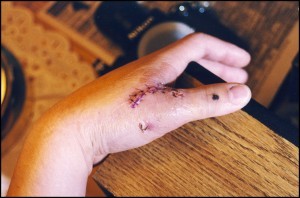Thumb Joint Pain Treatment
Effective treatment of thumb joint pain can vary from a simple thumb spica to an advanced microscopic thumb surgery. However, it is the appropriate selection of treatment options, that influences the outcome, much more, than the number of dollars spent on it. Over treatment in the form of aggressive physical therapy, excessive use of splints or medications, is not only linked with a wastage of resources, but can also make an acute injury into a chronic degenerative disorder. Hence, the therapy of thumb joint pain, has to be done by an orthopedist or a physical therapist, depending on the nature of the injury.
Once the process of thumb joint pain diagnosis is meticulously completed, an appropriate treatment option can be promptly chosen and executed. The basic principles involved in dealing with a traumatic thumb joint injury, consist of
- Reduction – which involves bringing back the natural alignment between the broken ends of bones, joints, or ligaments.
- Immobilization – which consists of maintaining the natural alignment between the injured parts until they heal.
- Physical therapy – which brings back the lost muscle strength and joint movements with the help of various exercises.
Degenerative diseases causing thumb joint pain, have a completely different mechanism, hence, their treatment has to proceed in a different manner. The changes taking place in the soft tissues of the thumb have to be considered the prime target of treatment options. Newer treatment options, like prolotherapy, have given promising results in majority of patients, giving the hope of a permanent cure to the many chronic thumb joint pain sufferers.
Thumb Spica for Thumb Joint Pain
Thumb spica is an appliance for immobilization of the thumb for therapeutic purposes. It is very useful in thumb joint pain, where it provides rest to the muscles and joint, and helps in early healing of thumb injuries. A thumb spica can be in 2 forms, i.e. cast or splint. A thumb spica cast is made up of plaster of Paris and is directly molded over the injured thumb, wrist, and forearm. It is more beneficial in traumatic thumb injuries, where a strict immobilization is needed.
What is a Thumb Spica Splint?
A thumb spica splint is a fabric enclosed pliable metal strip, which provides support and maintains the thumb in a fixed position. The fitting of a thumb spica can be adjusted by bending the metal strip or varying the tension on the Velcro straps.
Thumb Spica Splint Advantages
A thumb spica does not provide strict immobilization and permits mild degree of movement at the thumb joints. This is highly suitable for minor injuries, as it prevents weakening of muscles and excessive joint stiffness.
It is highly comfortable and user-friendly with lesser complications of allergies or itchiness.
Thumb Spica Splint Disadvantages
Due to the user-friendly nature of the thumb spica, some patients tend to ignore the seriousness of their thumb joint pain, and fail to even follow basic instructions given to them. It acts as a false sense of security, which greatly increases the chances of a repeat injury or causes improper healing due to the ineffective immobilization.
Certain over-cautious people tend to wear a thumb spica, even after complete recovery from a thumb injury. This type of behavior increases the stiffness of the thumb joint and also weakens the muscles of the thumb due to disuse atrophy.
Thus, it is very important to use a thumb spica, exactly as directed by an orthopedist, and not continue its use beyond 3-4 weeks.
Surgery for Thumb Joint Pain
Thumb joint pain surgery (Picture 1) mainly focuses on traumatic conditions of the thumb, like fractures, ligament tears, and so on. Prompt surgery immediately after an injury is an essential prerequisite for fractures and dislocations. But for ligament injuries, it is advisable to wait for the bruise and inflammation to settle down, which may take 1-2 weeks, before performing any surgical intervention. This is because, the immune response immediately after injury makes soft tissues around the thumb more friable and prone to injury.
Picture 1: Thumb Joint Pain Surgery
(Source: Wikimedia Commons)
A hand surgeon is more reliable in surgical treatment of thumb joint pain as compared to a general orthopedist. The surgeries are generally performed under an operating microscope and require special expertize in that field. The orthopedic screws or plates used for this surgery should be made up of a non-reactive and non-magnetic material, like titanium, for better durability. Though, stainless steel and other materials are cheaper and readily available, but in the longer run, they definitely have several disadvantages.
Post-operative precautions and level of activity depend on the stability achieved by the surgical fixation of the injured thumb. This should be followed religiously as per the instructions of the operating surgeon, who is the only first hand witness of the internal nature of the injury and the finesse of the surgery performed. Physical therapy with a soft ball or a dynamic splint begins approximately 2-3 weeks after surgery. This helps to resolve the post-operative stiffness and regains the range of movements for the thumb and the other fingers.





